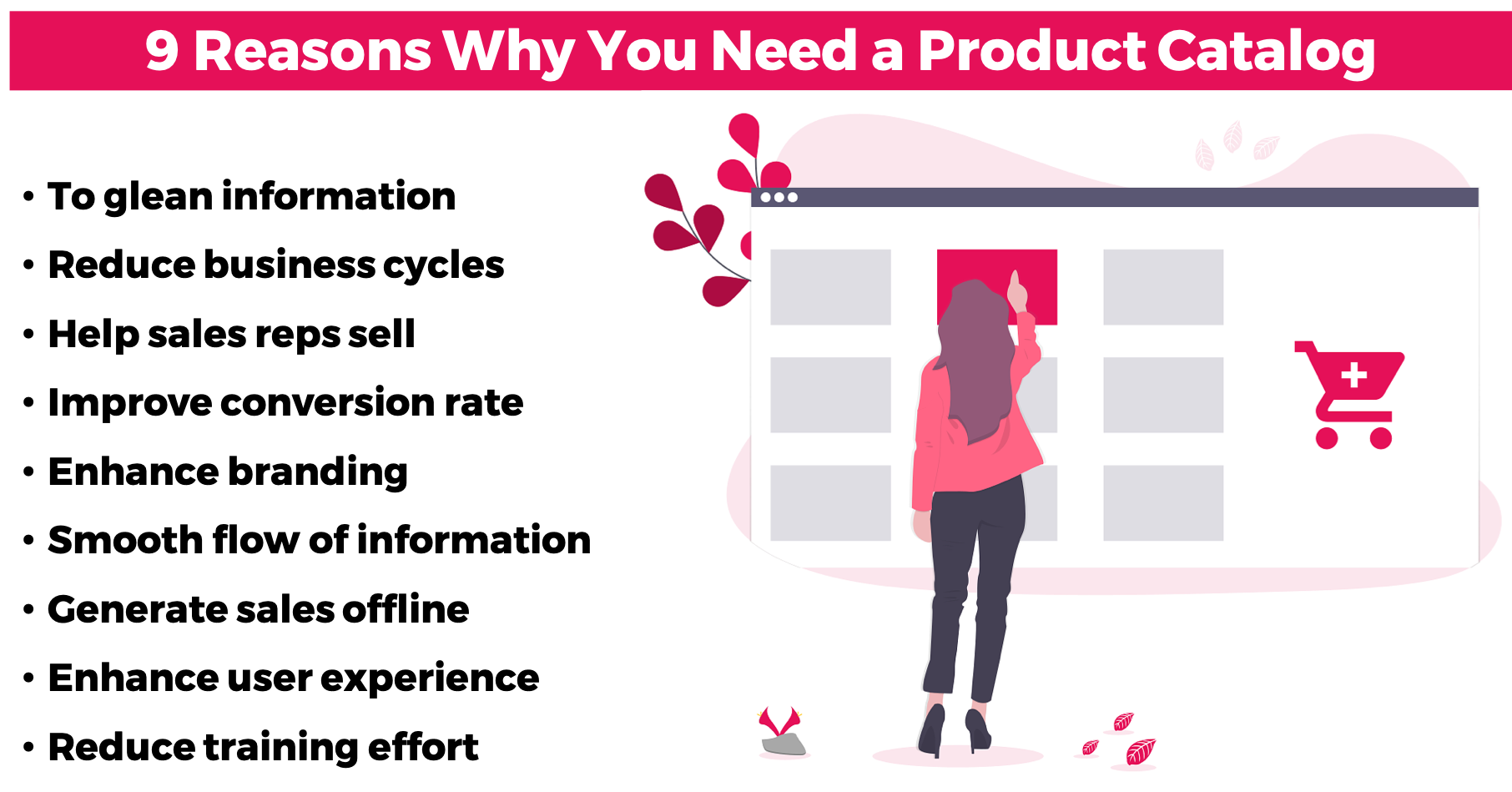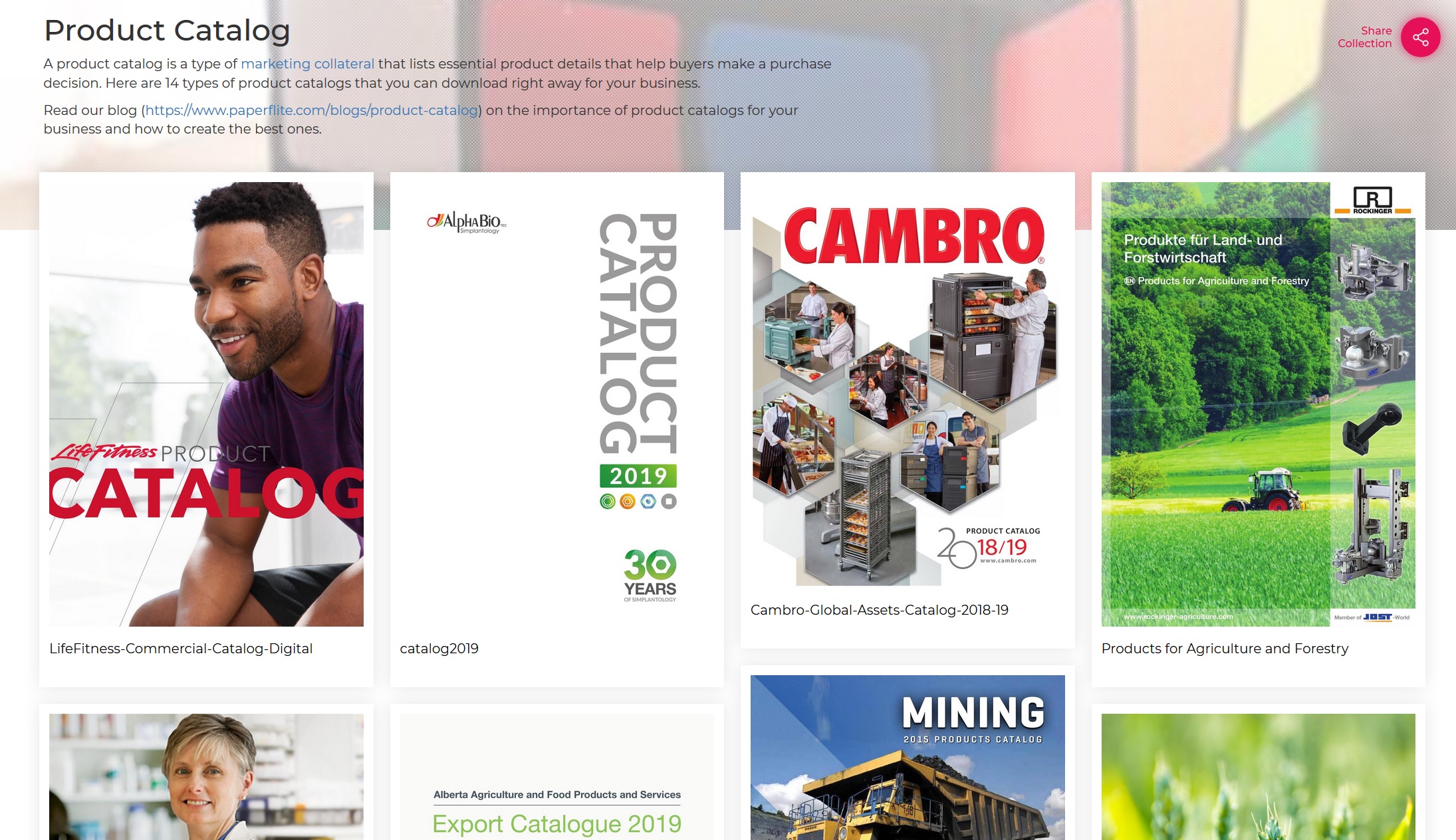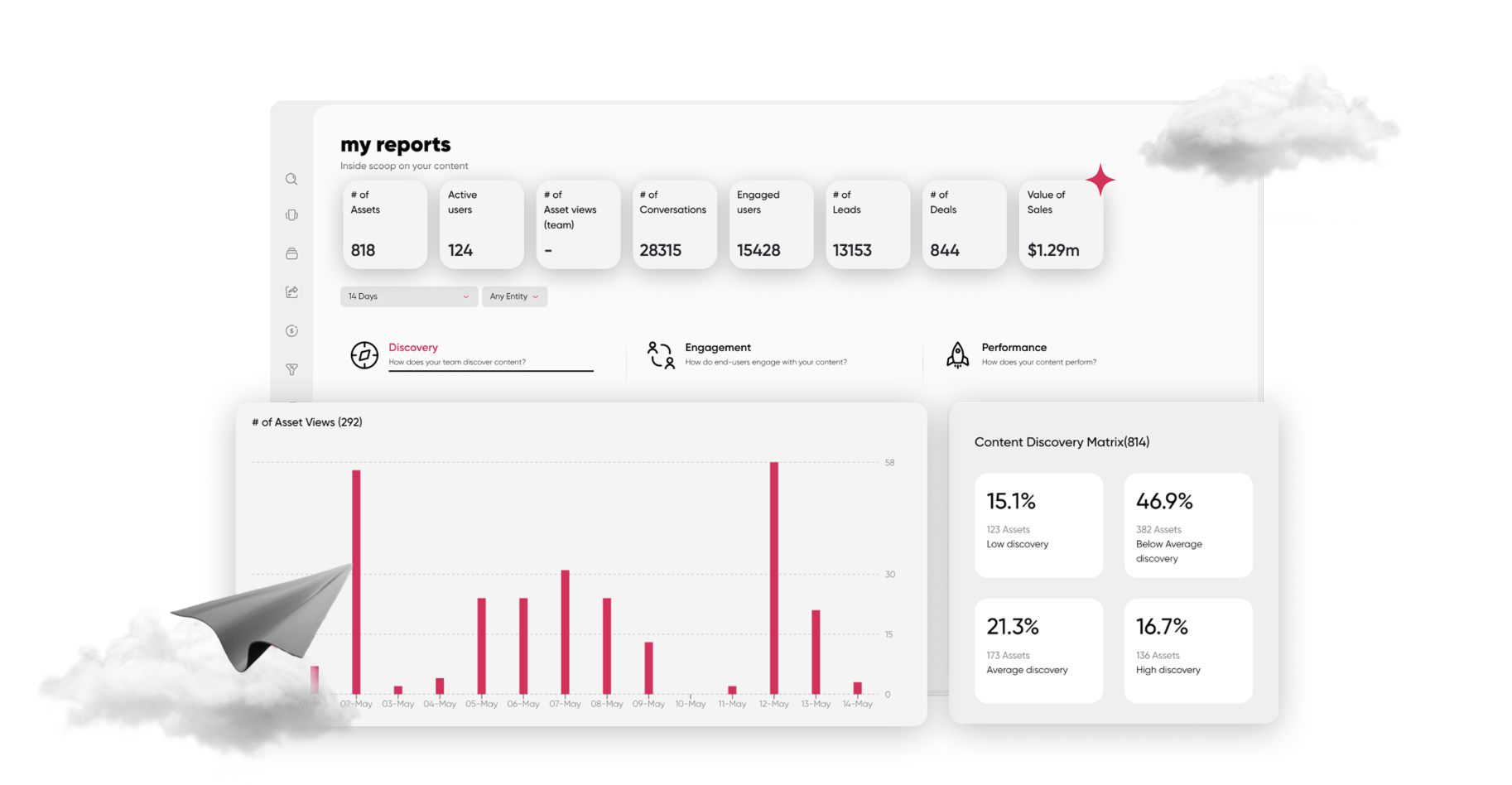What is a Product Catalog & Why Do You Need It? [Free Templates Included]
A detailed primer on product catalogs and their utility to modern businesses.
What is a Product Catalog?
A product catalog is a type of marketing collateral that lists essential product details that help buyers make a purchase decision. These details include product features, descriptions, dimensions, price, weight, availability, color, customer reviews, and more.
The best example of a product catalog is the Amazon marketplace, where you can get a host of information in a single click. Think about a book that you've been trying to buy - Amazon lists all the information that you need. It includes the book title, author name, publisher's name, number of pages, a brief snapshot of the book, price, dimensions, offers/discounts, reviews, and more.
These documents are quite common both in the B2B and B2C domains.
"A product catalog is a type of marketing collateral that lists essential product details that help buyers make a purchase decision."
Who Needs Product Catalogs?
Product catalogs are useful to several business users and groups such as sales reps, inside sales, buyers, store clerks, field marketers, and managers. Here's how each group uses it:
- Sales reps and inside sales teams use a product catalog to convey vital information about a product or a service to their customers. They can refer to it while communicating with their prospects and customers about the benefits of using their products.
- Buyers and decision-makers need it as reference material while making a purchase decision. It helps them to compare different products/services from various vendors and decide the most suitable option for their business.
- Store and warehouse managers, shift managers, and operators use it to know about the details of the inventory in their godowns.
- Field marketers can use it while they are walking customers through demos of their products and solutions. It helps them dive deep into their offering and offer value to their customers as the latter group is experiencing the product.
- External parties such as agencies, partners, resellers, and value-added sellers use it to get information about a product and service and sharing it with end-users.
9 Important benefits of product catalogs
Before we go any further, let us understand why we need product catalogs.
-
To Glean Information
Catalogs centralize this data in a digestible, accessible format that is available on the website—helps both internal teams and customers understand offerings without relying on sales reps to explain every detail.
-
Reduce Business Cycles
Digital catalogs remove the bottleneck by giving customers direct access to relevant info, enabling them to progress through the buying journey faster—no unnecessary back-and-forth.
-
Help Sales Reps Sell
Salespeople shouldn’t waste time hunting for product data across teams and tools. Catalogs consolidate what they need—so they can focus on selling, not searching, also helps them to share information effortlessly to their customers and generate sales.

-
Improve Conversion Rate
Buyers make decisions faster when they have the context. Catalogs equip them with the info needed to get approvals, compare options, and take action—cutting down friction in decision-making.
-
Enhance Branding
Beyond function, catalogs are a branding asset. Thoughtful use of color, imagery, tone, and design cues reinforces your identity and builds recall—sometimes more effectively than your homepage.
-
Smooth Flow of Information
Catalogs enable consistent information sharing across departments and systems. When maintained via a CMS, they eliminate the chaos of outdated files, rogue decks, and version control nightmares.
-
Generate Sales Offline
In-store buyers often research online before purchasing. Mobile-accessible catalogs—through microsites, or landing pages,—arm them with the right info, even when your team isn’t around.
-
Enhances User Experience
Well-structured catalogs with rich visuals, clickable links, consistent formatting, and pricing clarity make the buying journey smoother—and create a seamless bridge between browsing and buying.
Build Product Catalogs That Captivates Your Buyers
-
Reduces Training Effort
Onboarding new reps, partners, or retailers becomes easier when product info is centralized and self-serve. Digital catalogs lower dependency on trainers and shorten ramp-up times.
Types of Product catalog:
Not every catalog wears the same hat. The right type of catalog depends on who you’re selling to and how you want to show off your products. Let’s break down the options—and figure out which one’s your perfect match:
Digital Interactive Catalog
Interactive catalogs let users browse, click, zoom, filter, even watch embedded videos or request a quote directly inside the catalog. They’re built for engagement, not just display.
Key features: Clickable product links, embedded media, search/filter tools, real-time updates.
When to use: Anytime you want your catalog to drive leads and revenue.
Looking to create a catalog that actually moves the needle?
Retail Catalogs
Retail catalogs are consumer-focused catalogs built to attract attention, showcase products visually, and trigger quick purchases.
Key Features: Visually rich layouts, lifestyle imagery, promotional highlights, curated collections, and clear pricing. Often delivered as print brochures or interactive digital flipbooks.
When to Use: Ideal for seasonal campaigns, new product launches, holiday sales, or any scenario where aesthetics and emotional appeal drive conversions.
B2B Catalogs
B2B catalogs are structured catalogs meant for business buyers who purchase in volume or through procurement workflows.
Key Features: Detailed specifications, tiered pricing, inventory availability, order forms, and integration with ERP or CRM systems.
When to Use: Best for industrial, wholesale, or reseller use cases—especially where accuracy, repeatability, and bulk transactions matter.
Sales Product Catalog
A specialized catalog tailored for sales reps—often containing pricing, promos, competitive comparisons, or customer-specific content.
Key features: More tactical than public-facing catalogs; built to close deals.
When to use: Enterprise sales teams needing customizable content.
What Should Go Into a Product Catalog? - Format & Structure
A well-structured product catalog isn’t just a list of items—it’s a strategic asset. Whether you’re selling to consumers or businesses, it must balance visual appeal with detailed, actionable information. The goal? Help different stakeholders—buyers, sellers, and decision-makers—find what they need and act on it.
1. Introduction Page
Sets the tone with a brief brand overview, mission, and what readers can expect. Keep the design clean, aligned with your brand identity, and supported by high-quality visuals.
2. Table of Contents
Organize product categories logically—by type, use case, or alphabetically. Use legible fonts and consider thumbnail visuals for quicker navigation.
3. Product Listings
This is your core. Each product entry should include:
- Product Name & Version
- Description & Features – Short, scannable, benefit-led
- Specifications – Dimensions, size, materials, ideal usage conditions
- Images – Multiple angles + lifestyle/context shots
- Certifications – ISO or industry-specific standards
- Safety Measures – If relevant for product usage
- Warranty/Guarantee – Clear, concise terms
- Launch Year – Helps contextualize newer vs. older models
4. Pricing & Discounts
Details about the cost of each product, including any variations based on size, color, or other attributes.
Design Tips:
- Transparency: Clearly display prices, including any discounts or promotions.
- Structure: Use tables or charts to compare pricing tiers or bundles.
- Currency: Ensure prices are listed in the appropriate currency for your target audience.
5. Customer & Market Validation
Add credibility with customer testimonials, industry use cases, or success metrics. These act as social proof—especially for new or complex products.
6. Returns & Terms
Briefly outline your returns policy and any key terms & conditions a buyer should know up front.
7. Call-to-Action & Contact Info
Every section should lead to a next step—buy, inquire, download, share. Include email, phone, website, and even QR codes for quick access.
Design Tips:
- Placement: Position CTAs prominently, such as at the end of each section or on the back cover.
- Clarity: Use compelling language like "Order Now," "Contact Us," or "Learn More."
- Accessibility: Provide multiple contact options, including phone, email, and social media handles.
How to Create an Interactive Product Catalog:
1. Define Goals and Audience
Start by identifying who the catalog is for—B2B buyers, retail customers, channel partners, or internal sales reps. Each audience demands a different depth of detail and format. Knowing this upfront guides layout, tone, and navigation.
2. Gather Product Data and Assets
Collect everything: descriptions, technical specs, pricing, certifications, images, videos, diagrams, usage guidelines—whatever informs your buyer.
If you already have this content in PDFs or PPTs, Cleverstory lets you import and convert them directly into a catalog, saving time and duplication of effort.
3. Choose Your Format
Decide whether your catalog will be a static PDF, a basic flipbook, or an interactive format.
With Cleverstory, you can skip the design gruntwork—thanks to ready-to-use templates tailored for product experiences. And for visual-rich catalogs, you can pull high-quality images directly from Pexels without leaving the editor.
4. Design the Layout
Structure the catalog for clarity and ease of use. Think clean sections, consistent formatting, and logical flow.
Cleverstory’s bidirectional scroll allows for a more fluid navigation experience, especially for catalogs with nested product categories. Plus, it’s mobile-optimized by default, so you don’t have to rework layouts for smaller screens.
5. Add Interactive Elements
Make the catalog work harder for you:
-
Add smart gating to capture leads based on engagement level or user behavior.
-
Insert downloadable asset cards (like brochures, guides, or spec sheets) directly into product sections.
This gives users more value while giving you better visibility into their intent.
6. Distribute and Share
Once ready, you can embed the catalog directly into your website using a plug-and-play embed code, or share via email and QR codes.
Behind the scenes, Cleverstory tracks how each product performs—which pages were viewed, for how long, and by whom. You also get specialized lead reports that show the journey of each prospect through the catalog.
Product Catalog Examples & Template
Now that we have a fair idea of what is a product catalog, here are a few product catalog examples that designers could use to become inspired. Some of these are suitable for B2C companies, while others will be apt for B2B companies. Click on the image below to download any of these to get started right away.
Click on the image below to access the wide repository of 12 product catalog examples & template across different industries and companies that will inspire you create one for your business.

For starters, Rockinger's product catalog is 142-pages long, vivid in its imagery and has a detailed description of all its agriculture and forestry products. The product diagrams are accompanied by features and tables and have all the details that buyers will need before making a purchase decision. The document is in a two-sided format in English and German languages thereby catering to both target audiences.
The marketing team at Alberta Agriculture and Forestry knows how to design a catalog. It begins with a brief description of the Alberta region in Canada, its agriculture, and then delves into individual product categories such as bakery, beverages, cereals, etc.
It lists the suppliers and vendors (along with contact details) for each category accredited by the Canadian government. The images used in the product catalog speaks volumes of the effort that has gone into promoting the region's agriculture business.
Par Pharmaceutical's online product catalog is simple, yet effective. It lists down the different drugs, their dosages, generic names, package size, etc. An adjacent PDF document describes the molecular formation, indications, usage, and warnings.
Cambro is a 69-year old company with a vision to make a hospital meal tray of the highest quality possible. catalog caters to its business in the insulated transport, merchandising, ware-washing, and other categories. Each product captures details around the build, weight, dimensions, price, optional accessories, voltage, energy efficiency, etc.
The longest among the several product catalogs that we researched, it helps users understand the importance of granular details of such products.
Life Fitness's product fitness catalogs are a treat for the eyes. Their target audiences are owners/administrators from gyms, corporates, clubs, hotels, military establishments, and fitness boutiques. It includes the entire suite of products, apps, and services that the company offers to its members across different age categories.
Every fitness equipment has details around its design, build, material, and usage mechanism. With pictures of fitness specialists using the equipment, it enables buyers to easily relate with it and decide the best choices suitable for them.
AlphaBio has been providing solutions for dental implantology procedures for 30 years. The company's 2019 product catalog captures details of all their products, design features, composite material, dimensions, instructions, and clinical advantages. It is a universal document that helps dentists, surgeons, patients, partners, and distributors know what is on offer and how they could benefit from it.
Making the Most of Your Product Catalog
A catalog isn’t “set it and forget it.” To turn it into an engine for leads and sales, you need to manage it actively.
Managing & Updating Your Catalog

Products change. Prices change. Promotions expire. An outdated catalog hurts trust.
If you’re using a static format like PDF, updating = re-uploading = re-sharing = chaos.
With an interactive catalog? Updates go live instantly. One change, reflected everywhere. (Internal link: "content distribution tools")
Retrieving
Product catalogs must be easily retrievable by users who need them the most.
For example, an event marketer must be able to pull up his product datasheet on his iPad when he is staffing a booth or to talk to prospective customers on the sidelines.
Content management systems help event marketers to deliver the right marketing collateral at the right time to the right prospect.
Sharing & Distributing Your Catalog
Digital opens more doors than print:
- Embed it on your website.
- Send it in sales emails.
- Create personalized microsites, which contain multiple relevant product catalogs or other relevant brochures that buyers can browse through with ease.
- Create personalized link share it via WhatsApp, Slack, or even LinkedIn - this also helps you in tracking the performance your catalog.
Tracking/Analyzing Performance
Users must be able to gain insights from the usage of product information sheets. It includes the number of views, downloads, re-shares, and time spent on each document. CMSs are powered by analytics capabilities that help product managers, marketers, and sales reps to efficiently analyze product performance, boost sales, and deliver a personalized user experience.
For example, in an email campaign, sales reps must know which product catalog is providing the most value to buyers. It helps sales reps engage with customers meaningfully in sales conversations and fulfill their needs meticulously.

Get Actionable Insights That Moves Sales Forward
Using the catalog as sales enablement collateral
Your catalog isn’t just for browsing—it’s a tool reps can use in live demos or customer meetings.
Interactive catalogs let reps:
- Walk customers through product comparisons live.
- Embed explainer videos or demos.
- Link straight into CRM for follow-up tracking.
Generating Leads from Your Catalog
This is where the magic happens. Interactive catalogs can:
- Embed lead capture forms (“Want the full spec sheet? Enter your email.”)
- Gate downloads behind opt-ins.
- Trigger retargeting ads based on what products someone browsed.
- Add CTAs inside the catalog itself: “Request quote” / “Book a demo” / “Chat with us.”
Want your catalog to double as a lead-gen machine? Discover how Paperflite can transforms catalogs into conversion tools.
FAQs
What’s the difference between B2B and B2C catalog?
B2B catalog is built for businesses purchasing in bulk, needing detailed specs, pricing tiers, inventory levels, and often integration with procurement or ERP systems. It’s less about aesthetics, more about precision and utility. In contrast, a B2C catalog targets individual consumers—so it’s visual-heavy, emotionally driven, and optimized for ease of browsing, storytelling, and impulse buys.
What’s the typical size of a product catalog?
Depends on your product range, but anywhere from 12–80 pages is common.
How many pages should a product catalog have?
Product catalog should be long enough to cover your offerings clearly, but concise enough to stay user-friendly. Small catalogs run 4–12 pages, while large ones can exceed 40. Focus on structure over size—organize by category, include only what’s essential, and if digital, use interactive sections instead of fixed pages.
What’s a product catalog usually attached with?
Often tied to a broader marketing campaign, linked in sales emails, embedded on landing pages, or printed alongside trade show materials.
Product Catalogs - What You Still Need to Know
Buyers need to make decisions quickly, and businesses need to make their journeys seamless. Product catalogs must feature content that provides them with all requisite information. Hence, marketers must know what makes their product a must-have for buyers and include that information.
A product catalog isn’t just a document—it’s your storefront, your silent salesperson, your content hub.
And in 2025? A PDF doesn’t cut it anymore.
Rethink static catalogs. Explore interactive digital catalogs that engage, track, and convert.
